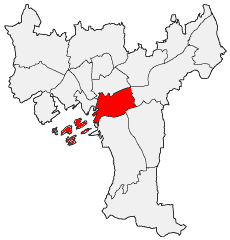
St. Hanshaugen is a borough of the city of Oslo, Norway.

Sagene is a borough of the city of Oslo, Norway. The area became part of the city of Oslo in 1859. The name Sagene itself is the plural of the Norwegian word for "saw", reflecting all the old industrial mechanical saws powered by the river Akerselva in this area in the 19th and early 20th centuries.

Grünerløkka [] is a borough but also a neighborhood of the city of Oslo, Norway. Grünerløkka became part of the city of Oslo in 1858. Grünerløkka was traditionally a working class district; since the late 20th century the area has increasingly undergone gentrification. Especially in the core neighborhood of Grünerløkka, property prices tend to be higher than what is typical of other Oslo East End boroughs.

Ullern is a borough of the city of Oslo, Norway.

Bjerke is a borough of the city of Oslo, Norway.
Helsfyr-Sinsen was a borough of the city of Oslo, Norway, from 1988 to January 1, 2004, when it was split up and merged into Alna and Gamle Oslo boroughs. It consisted of the neighborhoods Helsfyr, Teisen, Etterstad, Keyserløkka, Lille Tøyen, Valle, Løren, Carl Berners plass, Rosenhoff and Sinsen.

Frogner is a residential and retail borough in the West End of Oslo, Norway, with a population of 59,269 as of 2020. In addition to the original Frogner, the borough incorporates Bygdøy, Uranienborg and Majorstuen. The borough is named after Frogner Manor, and includes Frogner Park. The borough has the highest real estate prices in Norway.
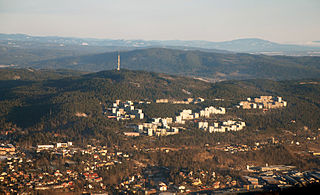
Grorud is a borough of the city of Oslo, Norway. The borough contains the Ammerud, Grorud, Kalbakken, Rødtvet, Nordtvet and Romsås areas. To the north of the borough is the forest of Lillomarka. The borough is the smallest in Oslo, with fewer than 30 000 inhabitants.

Vestre Aker is a borough of the city of Oslo, Norway. It has a population of 50,157 as of 2020.
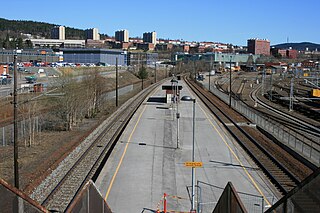
Alna is a borough of the city of Oslo, Norway. It is named after the River Alna, which flows through it.
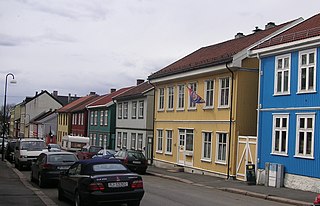
Vålerenga is a neighbourhood in the city of Oslo, Norway, belonging to the borough of Gamle Oslo. Vålerenga is located between the neighbourhoods of Gamlebyen, Jordal, Ensjø, Etterstad and Lodalen. Vålerenga is in particular known for its traditional, small wooden houses, and for its football and ice hockey-teams: Vålerenga IF Fotball and Vålerenga Ishockey.
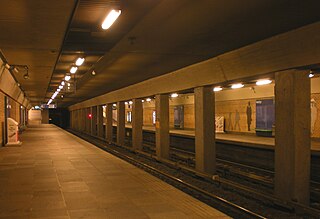
Helsfyr is a subway station on the east side of the Oslo Metro system located in the borough of Helsfyr. The station is shared by the Furuset Line, the Østensjø Line and the Lambertseter Line. Line 1 terminates at Helsfyr during weekends, late evenings, and vacations. The station is located between Ensjø in the west and Brynseng in the east.

Valle Hovin is both a bandy and speed skating rink in cold weather, and an outdoor stadium for concerts in warm weather, in Oslo, Norway.
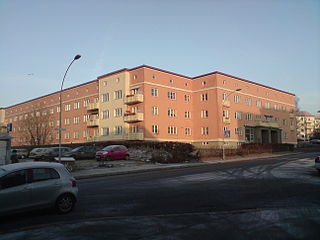
Etterstad is a neighborhood in Oslo, located between the river Alna and Strømsveien, north of Vålerenga. It was incorporated into Oslo in 1946, two years before the merger of Oslo and Aker. The area is mainly residential.
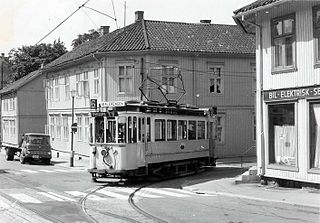
The Vålerenga Line, also known as Helsfyr Line and Etterstad Line, is an abandoned line of the Oslo Tramway of Norway. It branched from the Gamlebyen Line in Schweigaards gate and ran into the neighborhoods of Vålerenga, Etterstad and Helsfyr. The line followed the streets of Schweigaards gate, St. Halvars gate, Enebakkveien, one direction each in Vålerenggata and Strømsveien, and Etterstadgata. The line continued as a suburban light rail as the Østensjø Line and the Lambertseter Line.

The Politics and government of Oslo reflects that Oslo is the capital of Norway, and as such is the seat of Norway's national government. Most government offices, including that of the Prime Minister, are gathered at Regjeringskvartalet, a cluster of buildings close to the national parliament—the Storting.

Jordal is a neighbourhood in the borough of Gamle Oslo in Oslo, Norway.
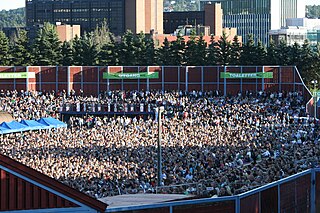
Valle-Hovin is a neighborhood in Oslo, Norway, best known for the sports and music venue of the same name.

Helsfyr is a residential and industrial neighborhood in Oslo. It is located in Oslo's East End, in the administrative borough of Gamle Oslo.

